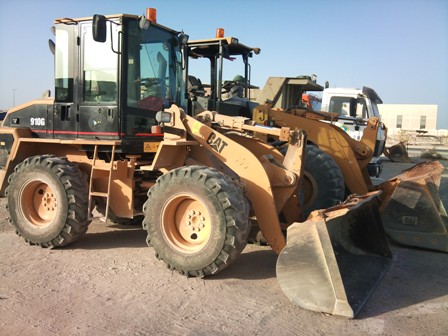Top Reasons For
Buying a Wheel Loader
Definition:
The Wheel Loader is construction equipment, and one of the most important heavy equipment the sewer contractor in Saudi Arabia needs to perform his work, and mainly for moving and loading of soil and sand.
Therefore, the contractor seeks to buy it or rent it for different periods because it is an essential tool for performing his projects.

The wheel loader uses rubber tires, and its speeds may reach up to 50 km/ h on flat surfaces. Please note that wheeled tracks gives dragging force less than bulldozers tracks.
We have two tires of wheel loaders:
Two tires and four tires tracks. The former type gives flexibility during driving and routing the equipment. So, the force of traction and rolling resistance is less because of few numbers of tires. However, the tracks with four wheels, provides more stability and security to the driver.
Buying the Equipment:
The Contractor yearly should assess the (efficiency, usefulness, expected life) of his equipment. Based on the result of the study and the planned size of future projects, he can decide which equipment to buy that can serve to perform his projects. In this case, you must check the investment budget in parallel with the presence of the necessary cash and bank facilities to see if it is possible to buy any new equipment or not.
The sewer contractor prefers to buy this equipment, because he needs it in order to perform his projects. Buying decision is subject to financial resource's availability, which must comply with the investment budget that is concerned to study any investment decision that benefits the company for a long-term.
How to choose the Proper wheel loader?
This equipment is an engineering (construction) tool that runs on two or four tires. We can classify them to four types depending on their specifications and the nature of their work:
1) Light work.
2) Medium work.
3) Hard work.
4) Difficult work and quarry work.
But how do we decide, which is the best equipment (Bulldozers or Wheel Loaders)?
We can check several factors before we decide which equipment to choose, such as:
A) Soil type.
B) Volume of the required work.
C) Length and slope of workplace.
D) Availability and productivity.
E) Cost.
The specifications of this tool vary depending on the manufacturer:
A) Net Horsepower (kW).
B) Operating Weight - Pounds (kgs).
C) Bucket Capacity - Cubic Yards (cu m).
D) Max Dump Height - Feet (meters).
For example, the Caterpillar wheel loader, Model 902 has the following specifications:
A) Net Horsepower (kW): 45 (34).
B) Operating Weight - Pounds (kgs): 9,600 (4,360).
C) Bucket Capacity - Cubic Yards (cu m): 1.3 (1).
D) Max Dump Height - Feet (meters): 9.9 (3).
While, model 994 d, has the following specifications:
A) Net Horsepower (kW): 1,250 (933).
B) Operating Weight - Pounds (kgs): 421,600 (191,200).
C) Bucket Capacity - Cubic Yards (cu m): 19.5-41 (15-31).
D) Max Dump Height - Feet (meters): 27.9 (8.5).
Advantages:
A) Its lightweight enable the operator to maneuver easily (move and rotate).
B) It is suitable for narrow places.
C) Its price is less compared to the bulldozer.
D) Easy to transport from one location to another (do not need a low bed trailer).
Disadvantages:
It is unbalanced sometimes because of its lightweight compared to the bulldozer, and this could lead to overturn, especially if it was loaded with loads on an uneven ground.
Operators:
Usually running this equipment is not difficult and can be learned, but the important matter is to run it safely and effectively. The operator should know the equipment nature and how to keep the work performance safe, especially when he deals with different workers at the workplace.
Therefore, it is preferable the operators of these equipments pass the necessary training courses to be licensed drivers. Because, running the equipment wrongly may lead to incidents that may hurt the operator, workers and the equipment itself. For example. Loading the equipment with loads more than it can hold leads it to deviate from its path and overturn.
Role:
The role of this equipment is to load, unload and dig of soil and dirt.
Safety procedures:
To preserve the safety of the operator, equipment and other surrounding workers, you should follow the following steps:
A) Do not load the equipment with loads more than it can hold, because it may affect its balance state and the bucket performance.
B) The operator should wear ear protector, because running this equipment is usually accompanied by noise, which may lead to hearing damage.
C) Usually running of this equipment is associated with emitting diesel smoke, which is harmful to health. So, the operator should wear a nose protector, to prevent breathing the smoke.
D) The operator should wear a seat belt when he drives the equipment.
E) The operator should use a clear concerted signal's language between him and other workers around the equipment.
F) The operator must be equipped with a wireless radio to ease to communicate with the supervisor who guides the work at the workplace.
G) A red light should be fixed on the back side of the equipment and to produce a clear sound to alert the workers around the equipment in case of turning back.
Maintenance:
This equipment should be subject to regular maintenance by qualified personnel according to the proper maintenance procedure set by the manufacturer. The main parts (bucket, tires, steering, brakes, and lights) of it must be inspected continuously to ensure its safety and suitability for work.
Return from Wheel Loader page to Equipment Management Page
Return from Wheel Loader Page to Sewer Contractor Management Guide Page